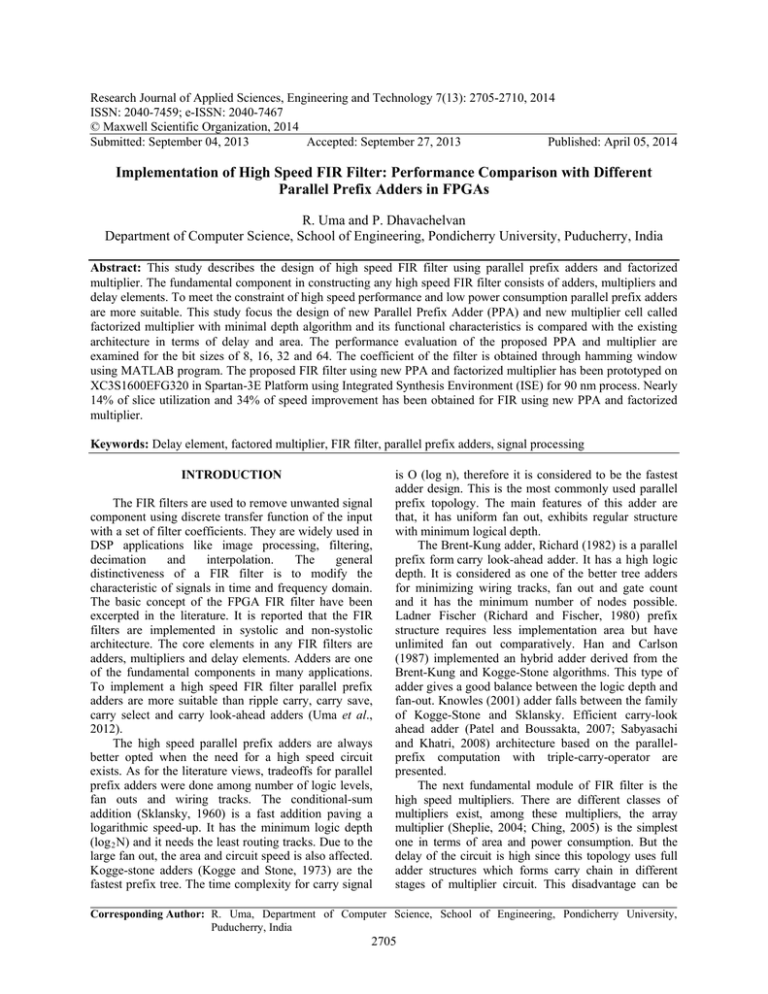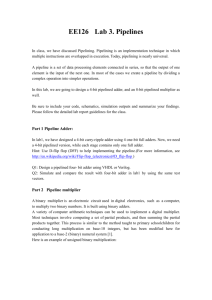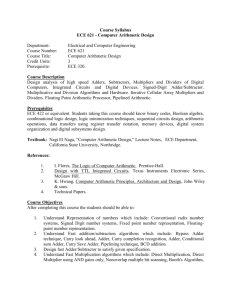Research Journal of Applied Sciences, Engineering and Technology 7(13): 2705-2710,... ISSN: 2040-7459; e-ISSN: 2040-7467
advertisement

Research Journal of Applied Sciences, Engineering and Technology 7(13): 2705-2710, 2014
ISSN: 2040-7459; e-ISSN: 2040-7467
© Maxwell Scientific Organization, 2014
Submitted: September 04, 2013
Accepted: September 27, 2013
Published: April 05, 2014
Implementation of High Speed FIR Filter: Performance Comparison with Different
Parallel Prefix Adders in FPGAs
R. Uma and P. Dhavachelvan
Department of Computer Science, School of Engineering, Pondicherry University, Puducherry, India
Abstract: This study describes the design of high speed FIR filter using parallel prefix adders and factorized
multiplier. The fundamental component in constructing any high speed FIR filter consists of adders, multipliers and
delay elements. To meet the constraint of high speed performance and low power consumption parallel prefix adders
are more suitable. This study focus the design of new Parallel Prefix Adder (PPA) and new multiplier cell called
factorized multiplier with minimal depth algorithm and its functional characteristics is compared with the existing
architecture in terms of delay and area. The performance evaluation of the proposed PPA and multiplier are
examined for the bit sizes of 8, 16, 32 and 64. The coefficient of the filter is obtained through hamming window
using MATLAB program. The proposed FIR filter using new PPA and factorized multiplier has been prototyped on
XC3S1600EFG320 in Spartan-3E Platform using Integrated Synthesis Environment (ISE) for 90 nm process. Nearly
14% of slice utilization and 34% of speed improvement has been obtained for FIR using new PPA and factorized
multiplier.
Keywords: Delay element, factored multiplier, FIR filter, parallel prefix adders, signal processing
INTRODUCTION
The FIR filters are used to remove unwanted signal
component using discrete transfer function of the input
with a set of filter coefficients. They are widely used in
DSP applications like image processing, filtering,
decimation
and
interpolation.
The
general
distinctiveness of a FIR filter is to modify the
characteristic of signals in time and frequency domain.
The basic concept of the FPGA FIR filter have been
excerpted in the literature. It is reported that the FIR
filters are implemented in systolic and non-systolic
architecture. The core elements in any FIR filters are
adders, multipliers and delay elements. Adders are one
of the fundamental components in many applications.
To implement a high speed FIR filter parallel prefix
adders are more suitable than ripple carry, carry save,
carry select and carry look-ahead adders (Uma et al.,
2012).
The high speed parallel prefix adders are always
better opted when the need for a high speed circuit
exists. As for the literature views, tradeoffs for parallel
prefix adders were done among number of logic levels,
fan outs and wiring tracks. The conditional-sum
addition (Sklansky, 1960) is a fast addition paving a
logarithmic speed-up. It has the minimum logic depth
(log 2 N) and it needs the least routing tracks. Due to the
large fan out, the area and circuit speed is also affected.
Kogge-stone adders (Kogge and Stone, 1973) are the
fastest prefix tree. The time complexity for carry signal
is O (log n), therefore it is considered to be the fastest
adder design. This is the most commonly used parallel
prefix topology. The main features of this adder are
that, it has uniform fan out, exhibits regular structure
with minimum logical depth.
The Brent-Kung adder, Richard (1982) is a parallel
prefix form carry look-ahead adder. It has a high logic
depth. It is considered as one of the better tree adders
for minimizing wiring tracks, fan out and gate count
and it has the minimum number of nodes possible.
Ladner Fischer (Richard and Fischer, 1980) prefix
structure requires less implementation area but have
unlimited fan out comparatively. Han and Carlson
(1987) implemented an hybrid adder derived from the
Brent-Kung and Kogge-Stone algorithms. This type of
adder gives a good balance between the logic depth and
fan-out. Knowles (2001) adder falls between the family
of Kogge-Stone and Sklansky. Efficient carry-look
ahead adder (Patel and Boussakta, 2007; Sabyasachi
and Khatri, 2008) architecture based on the parallelprefix computation with triple-carry-operator are
presented.
The next fundamental module of FIR filter is the
high speed multipliers. There are different classes of
multipliers exist, among these multipliers, the array
multiplier (Sheplie, 2004; Ching, 2005) is the simplest
one in terms of area and power consumption. But the
delay of the circuit is high since this topology uses full
adder structures which forms carry chain in different
stages of multiplier circuit. This disadvantage can be
Corresponding Author: R. Uma, Department of Computer Science, School of Engineering, Pondicherry University,
Puducherry, India
2705
Res. J. App. Sci. Eng. Technol., 7(13): 2705-2710, 2014
solved by using carry save (Wallace, 1964) adders by the
structure of Wallace Tree. This Wallace Tree multiplier
reduces the ripple carry delay in the internal adder
circuits, thereby reducing the propagation delay of the
circuit. In the reference (Baugh and Wooly, 1973)
presents modified booth algorithm with radix-4 cellular
array modular multiplier circuit. This type of multiplier
reduces the number of iterations by using pipeline
structure and direct radix-2 implementation of
Montgomery.
This study describes the design of high speed FIR
filter using new parallel prefix adders and factorized
multiplier to meet the constraint of high speed
performance and low power consumption.
Fig. 1: Black and gray cell
(a) 8-bit proposed PPA
(b) 16-bit proposed PPA
(c) 32-bit proposed PPA
(d) 64-bit proposed PPA
MATHEMATICAL MODELING OF
PARALLEL PREFIX ADDER
This section presents the implementation and
simulation output of proposed Delay-Area efficient PPA
and multiplier circuit design using factorization method.
Parallel prefix adders allow more efficient
implementation of the carry look-ahead technique. These
are nothing but a two level carry look-ahead adders. The
addition in PPA is usually expressed in terms of carry
generation signal g j , carry propagation signal p j , carry
signal c j and sum signal s j at each bit position (1≤j≤n):
g j = a jbj
(1)
p=
a j ⊕ bj
j
(2)
if j = 1
C j = {g j
{g j + p j c j-1 if 2≤j≤n
(3)
s=
p j ⊕ c j −1
j
(4)
The extended consecutive bits carry and propagation
are computed as:
g j
if j = l; if n≥j>l≥1
G[ j:l ] =
G
P
G
+
[ j:m ] [ j:m ] [ m −1:l ]
(5)
pj
if j = l; if n≥j>l≥1
P[ j:l ] =
P
P
[
j
:
m
]
[
m
1:
l
]
−
(6)
Figure 1 shows two of basic components: g-p
generator, (G, P) and g generators, (G). They are denoted
by a black and grey cells respectively.
The proposed adder is the hybrid adder obtained
from the combination of Ladner Fischer and Han
Carlson. The first two stages of the adder follow Han
Carlson adder topology and the remaining stages follow
the Ladner Fischer adder. These networks have low gate
Fig. 2: Proposed adder for 8, 16, 32 and 64-bit
counts. This adder concentrates on the design of a
parallel prefix network with a minimal depth case. The
main limitation exists in Ladner Fisher adder is that the
lateral fan out of the prefix cells doubles at every levels.
Thus additional buffers are used, as this drawback can
adversely affect the performance. This can be eliminated
through near minimum depth prefix algorithm using
(Richard and Fischer, 1980). The best characteristics of
both the adder are adopted in order to construct this
proposed adder. It has the order of log N and the
numbers of nodes are N/2-1 and N/4. The total number
of computational nodes are N-1+ (log 2 N-2) N/4. This
adder gives the most effective performance in the aspects
of delay and area. The proposed adder for 8, 16, 32 and
64 bit is depicted in Fig. 2.
The performance evaluation of the proposed PPA
and multiplier are examined for the bit sizes of 8, 16, 32
and 64. The target FPGA device chosen for the
implementation of these adders has been prototyped on
XC3S1600EFG320 in Spartan-3E Platform using
Integrated Synthesis Environment (ISE) for 90 nm
process. Structural data flow modeling using Verilog
HDL was used to model each adder. The optimization
targets for these adders are set to speed constraint
optimization. Table 1 presents the simulated results of
existing adders and proposed adder in terms of path
combinational delay and total slice utilization.
PROPOSED MULTIPLIER CIRCUIT USING
FACTORIZATION METHOD
The multiplier circuit is implemented using factoring
method. A method for multiplying numbers by factoring
one of the numbers into smaller parts. For example,
2706
Res. J. App. Sci. Eng. Technol., 7(13): 2705-2710, 2014
Table 1: Simulated results of existing and proposed parallel prefix adders
Sklansky
Brent kung
Kogge stone
------------------------ ------------------------- ------------------------Size
Delay (ns) Slices
Delay (ns) Slice
Delay (ns) Slices
8
10.0
9
9
8
10.4
16
16
11.0
27
18.4
21
12.8
35
32
20.8
52
23.8
51
14.3
122
64
23.9
121
30.2
122
18.8
274
Riyaz
-------------------------Delay (ns) Slices
10.1
12
19.4
22
34.2
51
52.3
117
Sabyasachi das
-------------------------Delay (ns) Slices
11.0
8
16.4
21
27.1
51
43.2
105
Proposed
-----------------------Delay (ns) Slices
8.91
9
13.90
18
18.30
38
22.10
80
Fig. 3: Simulation result of 8-bit proposed multiplier circuit
Table 2: Pseudo code for implementing 8-bit multiplier design
Pseudo code: //8-bit multiplier cell
Begin
A← input1
B ← input2
P← output
N←3
t Q , t R , t C ← internal computation variable
If (A<=2N)
t Q ←2N - A
t R ←{B, 000} //Concatenate the value of B with 3 zeros
t C ←B* t Q
P = tR - tC
else
t Q ←2N + A
t R ←{B, 000} //Concatenate the value of B with 3 zeros
t C ←B* t Q
P = tR + tC
End If
End
A = 1100, B = 1010 for (A>1000)
1010* (1000 + 0100)
1010*1000 + 1010*0100
Implementation of FIR filter:
FIR filter design using various parallel prefix adders:
For an N-tap FIR filter with coefficients h (k), whose
output is described by:
y ( n ) = h0 x ( n ) + h1 x ( n − 1)
+ h2 x ( n − 2)...hN −1 x ( n − N − 1)
The filter's Z transform is:
H ( z ) = h0 z −0 + h1 z −1 + h2 z _ 2 + ....hN −1Z − N −1
41×99 = 41x (100-1) = 4100-41 = 4059. For binary
multiplication of A and B, factor A into smaller number.
In designing 8-bit multiplier cell it is easier to factor the
number in terms of 8. This makes the computation
process simple by incorporating shift operation. The
number of adders used in the proposed multiplier cell
will be less by incorporating this factorization method.
The pseudo code for implementing this multiplier cell is
presented in Table 2 and its simulation result is shown in
Fig. 3. The comparison results obtained for array,
Wallace, booth multiplier with proposed work is shown
in Table 3. From the simulation result it can be observed
that the proposed multiplier cell utilizes less slices and
critical path delay when compare to the existing
multipliers.
For example consider the design of 8-bit multiplier
circuit:
A = 0110, B = 0101 for (A<=1000)
0101* (1000 - 0010)
0101*1000 - 0101*0010
(7)
or,
N −1
H ( Z ) = ∑ h( n) z − n
(8)
n =0
Different filter design has been reported in the
literature (Wei et al., 2008; Jiang and Bao, 2010). The
basic architecture of a linear FIR filter is shown in Fig. 4.
The design structure of this filter consists of adders,
multipliers, filter coefficients (h 0 , h 1 -h n-1 ) and delay
elements. The delay element is implemented as D flipflop. The filter coefficients are stored in ROM. A
processing element is implemented with adder and
multiplier. The processing element block will be called
or used as many number of time as per the requirement.
The coefficient of the filter using hamming window is
found through MATLAB program. The coefficient may
be signed fractional number which must be converted
into unsigned binary and scaled to a coefficient width of
5 and it is stored in ROM. The top block of 4-tap FIR is
shown in Fig. 5.
2707
Res. J. App. Sci. Eng. Technol., 7(13): 2705-2710, 2014
Table 3: Comparison of existing multiplier and proposed circuit
Multiplier
Bit size
Slices
Critical delay (ns)
Array
8
72
17.800
16
147
45.670
32
823
88.920
Wallace
8
90
14.130
16
387
37.460
32
1565
75.428
Booth
8
82
13.450
16
125
40.560
32
670
67.890
Proposed
8
34
11.118
multiplier
16
103
20.230
32
550
52.120
Routing delay
11.285
23.450
44.670
10.100
23.670
40.230
10.340
20.230
33.450
1.880
10.120
26.120
Gate delay
6.515
23.678
44.210
4.120
14.560
35.120
3.050
20.120
34.120
10.234
10.110
25.560
Logic level
22
48
96
11
36
76
14
32
47
7
22
52
Fig. 4: Basic architecture of a linear FIR filter
Fig. 5: Top block FIR filter
Fig. 6: Simulated result of 4-tap FIR filter
RESULTS AND DISCUSSION
The proposed 4-tap FIR is simulated with different
parallel prefix adders using Xilinx 12.1 ISE with
constraints fixed for speed and area optimization. The
filter coefficients are obtained for the following
specification using hamming windowing technique Filter
order-4, Type of window-hamming window, The
2708
Res. J. App. Sci. Eng. Technol., 7(13): 2705-2710, 2014
Fig. 7: Synthesis result of 4-tap FIR filter
Table 4: Comparison for FIR filter design using various adder topologies
Filter design with
Rise time delay
Hold on delay
various adder topology
(before clk) ns
(after clk) ns
Sklanshy
2.2340
36.570
Brent kung
2.1731
48.440
Kogge stone
3.5100
42.356
Riyaz
2.3450
39.650
Sabyasachi das
2.7560
40.987
Proposed
1.7310
35.600
Filter design with
various adder topology
Min. period (ns)
Frequency MHz
Sklanshy
2.345
270.37
Brent kung
2.445
286.36
Kogge stone
2.245
272.37
Riyaz
2.245
271.12
Sabyasachi das
2.451
290.16
Proposed
2.560
292.54
Min.: Minimum
frequency range: (fs = 42000 (sampling frequency),
fc = 10600 (cutoff frequency) and input bit size-32 bit.
The proposed FIR filter using new PPA and factorized
multiplier has been prototyped on XC3S1600EFG320 in
Spartan-3E Platform using Integrated Synthesis
Environment (ISE) for 90 nm process. The simulation
and synthesis report are presented in (Fig. 6 and 7). The
synthesis report shows the longest combinational path
between any two registers goes through just one
processing element. The synthesis tool report a
maximum clock period of 2.256 ns which allows this
filter to be run at 300 MHz with the proposed adder.
Table 4 presents the comparison between Filter
design with various parallel prefix adders and proposed
adder and multiplier.
CONCLUSION
The study presented the implementation of highly
efficient FIR Filter design with Delay-Area efficient
Slices
398
392
800
450
456
389
Improvement in slices (%)
2.261307
0.765306
51.375000
13.555560
14.692980
Total delay ns
56.540
52.731
39.540
47.123
47.879
37.137
Improvement in
delay (%)
34.31730
29.57274
16.07739
21.19135
22.43572
parallel prefix adder and multiplier circuit using factoring
method with minimal depth algorithm and its functional
characteristics is compared with the existing architecture
in terms of delay and area. The performance evaluation
of the proposed PPA and multiplier are examined for the
bit sizes of 8, 16, 32 and 64. The proposed FIR filter
using new PPA and factorized multiplier has been
prototyped on XC3S1600EFG320 in Spartan-3E for 90
nm process. The FIR filter design with the proposed
structure produces approximately 14% of the area
reduction and 34% of delay reduction when compare to
other existing parallel prefix adders.
REFERENCES
Baugh, C. and B.A. Wooly, 1973. A two’s
complementary parallel array multiplication
algorithm. IEEE T. Comput., C-22(12): 1045-1047.
Ching, Y.N., 2005. Low-power high-speed multipliers.
IEEE T. Comput., 54(3): 355-361.
2709
Res. J. App. Sci. Eng. Technol., 7(13): 2705-2710, 2014
Han, T. and D. Carlson, 1987. Fast area efficient VLSI
adders. Proceedings of the 8th Symposium on
Computer Arithmetic, pp: 49-56.
Jiang, X. and Y. Bao, 2010. FIR filter design based on
FPGA. Proceeding of International Conference on
Computer Application and System Modeling,
(ICCASM 2010).
Knowles, S., 2001. A family of adders. Proceeding of
the 15th IEEE Symposium on Computer
Arithmetic, pp: 277-281.
Kogge, P.M. and H.S. Stone, 1973. A parallel algorithm
for the efficient solution of a general class of
recurrence equations. IEEE T. Comput., 22(8):
786-793.
Patel, R.A. and S. Boussakta, 2007. Fast parallel-prefix
architectures for modulo 2n-1 addition with a
single representation of zero. IEEE T. Comput.,
56(11): 1484-1492.
Richard, P.B., 1982. A regular layout for parallel
adders. IEEE T. Comput., c-31(3): 260-264.
Richard, E.L. and M.J. Fischer, 1980. Parallel prefix
computation. J. Assoc. Comput. Mach., 27(4):
831-838.
Sabyasachi, D. and S.P. Khatri, 2008. A novel hybrid
parallel-prefix adder architecture with efficient
timing-area characteristic. IEEE T. VLSI Syst.,
16(3).
Sheplie, M., 2004. High performance array multiplier.
IEEE T. VLSI Syst., 12(3): 320-325.
Sklansky, J., 1960. Conditional-sum addition logic. IRE
T. Electron. Comput., EC-9(2): 226-231.
Uma, R., V. Vijayan, M. Mohanapriya and S. Paul,
2012. Area, delay and power comparison of adder
topologies. Int. J. VLSI Design Commun. Syst.,
3(1): 153.
Wallace, C.S., 1964. A suggestion for a fast multiplier.
IEEE T. Comput., 13: 14-17.
Wei, L., R.J. Yang and X.T. Cui, 2008. Design of FIR
filter based on distributed arithmetic and its FPGA
implementation. Chinese J. Sci. Instrum., 29:
2100-2104.
2710



